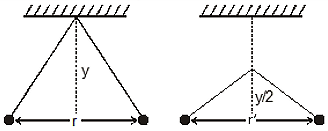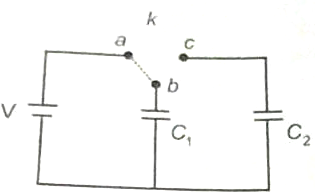Two parallel infinite line charges with linear charge densities are placed at a distance R. Electric field mid-way between the two line charges is-
1.
2. zero
3.
4.
Two pith balls carrying equal charges are suspended from a common point by strings of equal length, the equilibrium separation between them is r. Now the strings are rigidly clamped at half the height. The equilibrium separation between the balls now become:

1.
2.
3.
4. None of the above
An electric dipole is placed at an angle of 30 ° with an electric field intensity 2 x 105 N/C. It experiences a torque equal to 4 Nm. The charge on the dipole, if the dipole length is 2 cm, is
1. 8mC
2. 2mC
3. 5mC
4.
A hollow cylinder has a charge q coulomb within it(at the geometrical centre). If ϕ is the electric flux in unit of voltmeter associated with the curved surface B, the flux linked with the plane surface A in unit of voltmeter will be:
1.
2.
3.
4.
1. be reduced to half
2. remain the same
3. be doubled
4. increased four times
A toy car with charge q moves on a frictionless horizontal plane surface under the influence of a uniform electric field . Due to the force q, its velocity increases from 0 to 6 m/s in one-second duration. At that instant, the direction of the field is reversed. The car continues to move for two more seconds under the influence of this field. The average velocity and the average speed of the toy car between 0 to 3 seconds are respectively:-
1. 2 m/s, 4 m/s
2. 1 m/s, 3 m/s
3. 1 m/s, 3.5 m/s
4. 1.5 m/s, 3 m/s
Three-point charges + q and -2q and +q are placed at points (x=0, y = a, z = 0), (x = 0, y = 0, z = 0) and (x= a, y = 0, z = 0), respectively. The magnitude and direction of the electric dipole moment vector of this charge assembly are:
1. qa along + y direction
2. qa along the line joining points (x=0, y= 0, z= 0) and (x=a, y=a, z=0)
3. qa along the line joining points (x= 0, y=0, z=0) and (x=a, y=a, z=0)
4. qa along + x direction
X and Y are large, parallel conducting plates close to each other. Each face has an area A. X is given a charge Q. Y is without any charge. Point A, B, and C are as shown in the figure. Find the incorrect option.
1. the field at B is
2. the field at B is
3. the fields at A, B and C are of the same magnitude
4. the fields at A and C are of the same magnitude but in opposite directions
Consider the charge configuration and spherical Gaussian surface as shown in the figure. When calculating the flux of the electric field over the spherical surface, the electric field will be due to:
| 1. | \(q_2\). |
| 2. | only the positive charges. |
| 3. | all the charges. |
| 4. | \(+q_1\) and \(-q_1\). |
A solid conducting sphere of radius a has a net positive charge 2Q. A conducting spherical shell of inner radius b and outer radius c is concentric with the solid sphere and has a net charge –Q. The surface charge density on the inner and outer surfaces of the spherical shell will be
(1)
(2)
(3)
(4) None of the above
Two identical capacitors C1 and C2 of equal capacitance are connected as shown in the circuit. Terminals a and b of the key k are connected to charge capacitor C1 using a battery of emf V volt. Now disconnecting a and b terminals, terminals b and c are connected. Due to this what will be the percentage loss of energy?
(1) 75%
(2) 0%
(3) 50%
(4) 25%
In a region the potential is represented by V(x, y, z) = 6x – 8xy –8y + 6yz, where V is in volts and x, y, z, are in meters. The electric force experienced by a charge of 2 coulomb situated at point (1, 1,1) is :
1.
2. 30 N
3. 24 N
4.
Three concentric spherical shells have radii a, b and c (a<b<c) and have surface charge densities and respectively. If and denote the potential of the three shells, if c=a+b, we have
(1)
(2)
(3)
(4)
Charges +q and –q are placed at points A and B, respectively; which are at a distance 2L apart, C is the midpoint between A and B. The work done in moving a charge +Q along the semicircle CRD is :

1.
2.
3.
4.
Two metallic spheres of radii 2cm and 3cm are given charges 6mC and 4mC respectively. The final charge on the smaller sphere will be if they are connected by a conducting wire
(1) 4mC
(2) 6mC
(3) 5mC
(4) 10mC
In the given circuit if point \(C\) is connected to the earth and a potential of \(+2000~\text{V}\) is given to the point \(A\), the potential at \(B\) is:

| 1. | \(1500\) V | 2. | \(1000\) V |
| 3. | \(500\) V | 4. | \(400\) V |
A capacitor of withstands a maximum voltage of 6 kilovolt while another capacitor of withstands a maximum voltage of 4 kilovolt. If the two capacitors are connected in series, the system will withstand a maximum voltage of –
1. 2 kV
2. 4 kV
3. 6 kV
4. 9 kV
In the figure below, what is the potential difference between the point A and B and between B and C, respectively, in steady state?
1.
2.
3.
4.
Three uncharged capacitors of capacities and are connected to one another as shown in the figure.
Points A, B, and D are at potential and ,then the potential at O will be
1.
2.
3.
4.